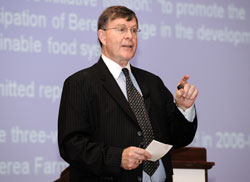Inside Iowa State
Inside ArchivesSubmit newsSend news for Inside to inside@iastate.edu, or call (515) 294-7065. See publication dates, deadlines. About InsideInside Iowa State, a newspaper for faculty and staff, is published by the Office of University Relations. |
Feb. 13, 2009 Symposium provides some eye openersby Diana Pounds The news was both sobering and uplifting for those attending the university-wide sustainability symposium earlier this week. More than 300 faculty, staff and students turned out for the Symposium on Enhancing Sustainability, held Monday night and all day Tuesday in the Memorial Union. The symposium was part of Iowa State's Live Green! initiative, which aims to turn ISU into a model of energy efficiency. Keynote speaker and Berea College president Larry Shinn provided some sobering shockers. If all 6 billion people on earth lived a $35,000-a-year American lifestyle, Shinn told listeners, two-and-a-half earths would be required to provide the necessary raw materials for the current generation. Shinn also pointed to a five-year United Nations study showing that 15 of 24 natural systems (such as fresh water, fisheries, biodiversity) that support human life are in decline or unsustainable. 
"Living upstream" is the practice of behaving as if we're 50 years upstream from our children and grandchildren. Symposium keynote speaker Larry Shinn, president of Berea College, said he challenges his college community to live upstream and think about the impact of their decisions now. Photo by Bob Elbert. Sustainable successHowever, Shinn also had encouraging words and a striking success story for those who aspire to make Iowa State a national model in conserving energy and resources. When Shinn became president of Berea in 1994, the Kentucky school, which serves students from southern Appalachia, had no commitment to ecological practices or studies. Fourteen years later, the university is a beacon of sustainability. There's an Ecovillage, where student families use 65 percent less energy and water than average families. Old buildings have been renovated with recycled materials, dual-flush toilets, an abundance of natural lighting, fans and windows that actually open. "If the outside air is clean, why recondition it?" Shinn asks. A new energy efficient heat plant is saving $1.2 million a year. Some buildings have geothermal heating and cooling. And a local food initiative promotes campus use of foods grown at the college and nearby farms. Living upstreamHow did the small college get to its impressive state of sustainability? We engaged in strategic thinking, educated ourselves at all levels and were willing to take many little steps along the way, Shinn said. During the process, Shinn challenged his university community to "live upstream." To live upstream is to behave as if we're 50 years upstream from our children and our grandchildren, he said. "We are those people standing upstream. How does that change the way we think about our actions?" Other presenters at the symposium included faculty, staff and students involved in environmental activities. Student panelA group of ISU students active in conservation activities offered a wishlist for ISU sustainability activities. They encouraged the university community to:
"I'm proud to be a member of the student body here at Iowa State," said sophomore Jared Ransom, "because I feel our sustainability program is leaps and bounds ahead of many other programs around the state." Recycling at Iowa StateStaff from facilities planning and management, dining and central stores briefed the symposium audience on campus recycling. Current programs include: White paper, newspaper, phone book and cardboard recycling. In 2008, these efforts saved the equivalent of 9,000 trees, 3.6 million gallons of water, 31,000 pounds of air pollution, 2 million kilowatt hours of electricity and 1,700 cubic yards of landfill. A composting program for yard waste, animal waste and, soon, dining food waste. The university compost facility moves to the new dairy facility this year. A budding recycling program in the residence halls. Currently 65 of 126 houses are involved. A dining program to recycle glass, paper, grease and boxes and reuse mugs and lunchboxes. Iowa State's carbon footprintUniversity architect Dean Morton defined "carbon footprint" as the total greenhouse emissions caused directly or indirectly by an individual organization, event or product. Ninety to 95 percent of ISU's carbon footprint involves the use of energy and fuels. Iowa State's energy and fuel use translates into a carbon footprint of 570,000 tons annually, he said. That's about 7 tons per year for a typical office or residence hall room. If Iowa State wanted to offset its carbon emissions with carbon-dioxide-consuming trees, it would require a 260,000-acre redwood forest. Live green"This is obviously an extremely important topic not only for the university, but for every single one of us individually," president Gregory Geoffroy said in closing remarks. "It is very uplifting to me to see the level of interest among our faculty, staff administrators and students. Thank you. We've got a lot of work to do, so let's get out there and live green." |
Quote"If the outside air is clean, why recondition it?" Larry Shinn |